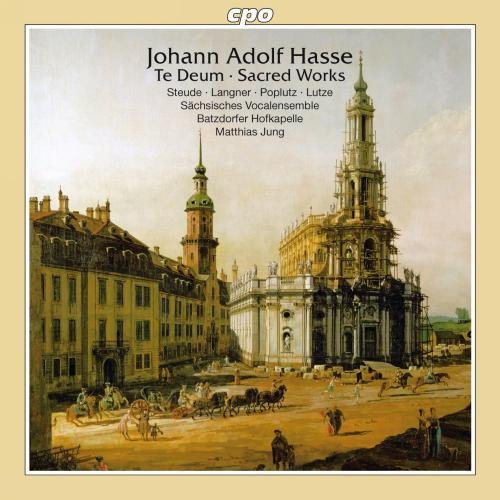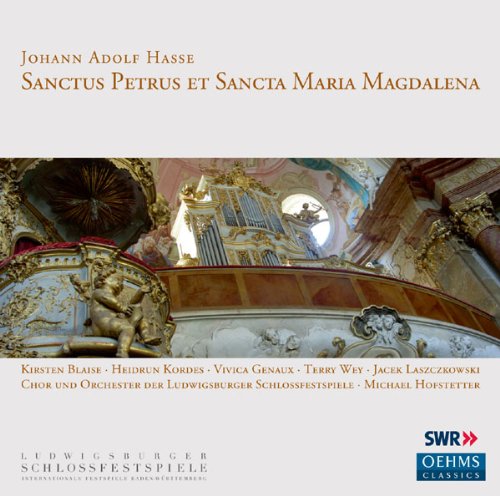Hasse Sacred Works
A spirited performance of the oratorio but the shorter works fail to ignite
View record and artist detailsRecord and Artist Details
Genre:
Vocal
Label: CPO
Magazine Review Date: 4/2011
Media Format: CD or Download
Media Runtime: 78
Mastering:
Stereo
Catalogue Number: CPO777 462-2

Composer or Director: Johann (Adolph) Hasse
Genre:
Vocal
Label: Oehms
Magazine Review Date: 04/2011
Media Format: CD or Download
Media Runtime: 78
Mastering:
DDD
Catalogue Number: OC950

Tracks:
| Composition | Artist Credit |
|---|---|
| Sanctus Petrus et Sancta Maria Magdalena |
Johann (Adolph) Hasse, Composer
Chorus of the Ludwigsburger Shlossfestspiele Heidrun Kordes, Soprano Jacek Laszczkowski, Soprano Johann (Adolph) Hasse, Composer Kirsten Blaise, Soprano Michael Hofstetter Orchestra of the Ludwigsburger Shlossfestspiele Terry Wey, Countertenor Vivica Genaux, Mezzo soprano |
| Miserere |
Johann (Adolph) Hasse, Composer
Chorus of the Ludwigsburger Shlossfestspiele Heidrun Kordes, Soprano Jacek Laszczkowski, Soprano Johann (Adolph) Hasse, Composer Kirsten Blaise, Soprano Michael Hofstetter, Conductor Orchestra of the Ludwigsburger Shlossfestspiele Terry Wey, Countertenor Vivica Genaux, Mezzo soprano |
Author: David Vickers
CPO’s collection presents six works all written after 1750 for the Dresden Hofkapelle; most of them are relatively concise, apart from the longer Litaniae lauretanae. Matthias Jung and his Saxon Vocal Ensemble have produced a few superb discs of Italianate church music in the past but on this occasion the dispirited atmosphere of proceedings prohibits sufficient charisma and spirit, as if either uninterested or distrustful in the material. For instance, the choral “Agnus Dei” that concludes the Litaniae lauretanae is flaccid, despite one sensing that Hasse’s music has plenty of potential for anyone desiring to go at it with more fervour. Soprano Barbara Steude’s contributions are insecure and inadequate, Batzdorfer Hofkapelle’s small group of strings sounds under-rehearsed and, although Jung’s pacing is immaculate, he seldom characterises the music. The concluding Regina coeli receives a more spirited performance, especially from the alto soloist Susanne Langner, but these perfunctory performances are unlikely to persuade any newcomers that Hasse is an unfairly neglected master of the mid-18th century.
Happily, a vitalised and compelling advocacy of Hasse is achieved by Ludwigsburg Castle Festival’s performance of Sanctus Petrus et Sancta Maria Magdalena. Written in the late 1750s for Venetian orphan girls to perform during Passiontide in the chapel of the Ospedale degl’Incurabili, with which Hasse had been associated since 1734, the short oratorio originally functioned like an extended introduction to an emotive Miserere in D minor (also appended here). Its libretto presents St Peter and Mary Magdalene disagreeing about who is most to blame for the death of Christ and, as one would expect, the five solo parts are all for high voices. Sensitive countertenor Terry Wey is impressive as St Peter; his anguished fast aria “Mea tormenta, properate!” is not merely representative of a missing link between the elderly Handel and adolescent Mozart but equal in dramatic and musical quality to either of them. “Sopranist” Jacek Laszczkowski is approximate and embarrassingly chronic as Joseph of Arimathea (he only gets one aria – sadly, the longest one), but the three ladies Kirsten Blaise, Heidrun Kordes and Vivica Genaux – all different Marias – combine sweetly in the trio “Amor meus in cruce languet”. The festival orchestra plays modern instruments in an excellent period style; Michael Hofstetter conveys Hasse’s work with dramatic passion and precision from the outset of the introductory sinfonia. Several imaginative accompanied recitatives are performed potently, and the finely crafted arias and duet are interpreted by both players and singers with total engagement and technical skill. The concluding Miserere is sung with animated luminosity by a choir of sopranos and altos. Oehms includes only the original Latin and a German translation of the libretto but the label deserves nothing less than admiration for slowly building an impressive catalogue of intriguing 18th-century repertoire.
Discover the world's largest classical music catalogue with Presto Music.

Gramophone Digital Club
- Digital Edition
- Digital Archive
- Reviews Database
- Full website access
From £8.75 / month
Subscribe
Gramophone Full Club
- Print Edition
- Digital Edition
- Digital Archive
- Reviews Database
- Full website access
From £11.00 / month
Subscribe
If you are a library, university or other organisation that would be interested in an institutional subscription to Gramophone please click here for further information.




